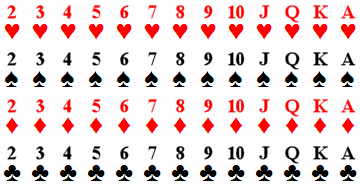Hearts the Card Game: Rules, Strategies, Modifications and How to Play for Money
Hearts is a well-known card game for four players (e.g., in the Windows environment), which can be played just for fun or for money. Even small stakes can spice up almost any game and provide motivation to strive for the best outcome. Learn how to play, master tactics, and explore fun modifications for an engaging gaming experience and playing for money.
Rules
Hearts is a card game for four players, played with a deck of 52 cards (from two to ace in four suits). All cards are dealt evenly among the players, each receiving a total of 13 cards. A similar card game for three players is Black Maria.

Figure 1: A Deck of 52 Cards
After dealing the cards, players play or discard cards, following two basic rules: (1) follow suit and (2) no need to trump. This means that if someone plays, for example, the Ten of spades, and I have a spade card, I must play it (follow suit). If I have two (or more) spade cards, such as the Eight of spades and the Ace of spades, I can choose which card to play (no need to trump) based on what is advantageous for me. If I don't have the suit that was led, I can discard any card (as we will see later, with only two exceptions). This allows for strategic play and making unfavorable cards for opponents. You can also tactically strategize.
Hearts are played in rounds (one deal = one round), until one of the players reaches the prescribed number of points—see Scoring and the goal of the game. To make the game more interesting, in the first round, each player discards their three (worst) cards and passes them to the opponent on the left, in the second round to the right, and in the third round to the opponent opposite. In the fourth round, each player keeps all their own cards and then again to the left, to the right, opposite, keeping cards, etc. Each round always starts with the player with the Two of clubs – they must play it as the first card.
Two Exceptions to the Rules
- In the first trick, hearts and the Queen of spades cannot be discarded, i.e., cards carrying penalty points (see the next chapter).
- A player cannot play hearts until they have been broken, i.e., played in the previous course of the game. For example, if a player led clubs, and if I don't have them, I can discard any heart card. Hearts are then broken and can be played at any time as any other suit and by any player.
Probability Insight
It is said that an exception proves the rule. Each player receives 13 cards. There are 13 heart cards and the Queen of spades is 1. What if a player gets all heart cards or 12 heart cards and the Queen of spades? Then they could break the rule that penalty cards cannot be played in the first trick. However, do you know the probability of this event?
There are only 14 favorable combinations (mathematically "14 choose 13"), and the total number of combinations – i.e., different combinations of 13 cards from a deck of 52 cards – that you can get is "52 choose 13", i.e., 635,013,559,600. The probability of getting all penalty cards is then 14 to 635,013,559,600, i.e., 1 to 45,358,111,400, meaning 1 in about 45 billion.
This is a lower probability than in numerical lotteries, such as Eurojackpot.

Figure 2: Hearts (source: Craiyon)
Scoring and the Goal of the Game
The player with the highest card, in the suit that was led, takes the trick. The trick itself has no meaning; attention is only paid to its contents. Heart cards and the Queen of spades serve as penalty points. The goal of the Hearts game is to get as few points as possible. For each heart card a player takes (in the pile), they receive 1 point. Taking all hearts would mean 13 points. The Queen of spades is the worst card. The player in whose pile it appears receives 13 points.
Hearts game goal: collect as few penalty points as possible. The game ends when one of the players reaches the preset number of points. For example, the player who first reaches 50 points loses and pays the other three players (their score becomes 50 points).
Shooting the Moon
However, there is an exceptional case that could be called a royal game – in Windows, it is referred to as Shooting the Moon. If a player manages to shoot the moon, i.e., take all hearts and the Queen of spades, they receive no penalty points, and, on the contrary, all other players receive 26 points.
After each round, points are recorded in a table. The game ends when any player reaches or exceeds 100 points (points are counted after completing the entire round), and the player with the least penalty points wins.

Figure 3: Shooting the Moon (source: Craiyon)
Tactics
Tactics come into play right after dealing the cards: "Which three cards should I pass to my opponents?" It is necessary to think not only about getting rid of your three worst cards (usually high ones) but also whether they could help the opponents, for example, to have all high cards, risking that they will take all hearts and the Queen of spades (shooting the Moon).
You can attempt to shoot the Moon when you have all or most of the high cards (preventing anyone from taking the stack, i.e., picking up a pile where hearts or the Queen of spades are) or if you have a so-called long suit, i.e., many cards of the same suit. In this case, opponents won't be able to counter, and you will most likely collect all hearts and the Queen of spades.
Usually, it's good to get rid of high cards (aces and pictures). It's always a good idea to consider whether to pick up with a high card, which gives you the right to lead in the next trick. Especially if it's your turn, otherwise there might be a risk (if you don't have an overview of the cards that have been played, especially the Queen of spades), that someone pass unwanted cards to you.
It's good to keep the Ace of hearts in case you decide to shoot the Moon based on the course of the game, or as insurance if someone else attempts it. However, it's worth noting that even the Ace of hearts may not help you, for example, in a situation where a player has the last three cards, the Queen, King, and Ace of spades. If this player is in turn, playing any card will not be able to be beaten by anyone (the strongest card is determined by the suit that was led, hearts are not a trump that could beat it).
Playing Hearts for Money
Quite simply. Before starting the game, players agree on the betting amount. For example, 1 point = 10 cents. Bets can be increased or decreased based on mutual agreement of players before starting a game.
After each round, hearts are counted and the presence of the Queen of spades in the stacks of each player, and accordingly, players contribute to the bank, or everything can be settled only after the complete end of the game, when one of the players reaches the limit of 100 points (players can agree to adjust this limit). In any case, points need to be recorded in a table.
The money accumulated in the bank is divided among the winners, for example, in a ratio commonly used in Poker 50:30:20 (although there are usually more players):
- Player takes 50% of the bank;
- Player takes 30% of the bank;
- Player takes 20% of the bank;
- The last player takes nothing and was the biggest contributor to the bank.
If, after completion, two or more players have the same number of points, the prize is divided equally. For example, the first two players have the same number of points, so each receives 40% of the bank (50% + 30% divided by two). It is also possible to play in a way where the winner takes it all.
Variations of the Hearts Game: Rule Modifications
Jack of Diamonds
The rule of the Jack of diamonds can liven up the game of Hearts significantly. The Jack of diamonds has a value of -10 points. Yes, a player who acquires the Jack of diamonds can deduct 10 points. This greatly increases the variability of the game and tactical options. It is also interesting that each of the four suits now has its meaning: hearts and the Queen of spades are penalty points, the game starts with clubs (Two of clubs), and the Jack of Diamonds even reduces penalty points.
Passing Cards to Opponents
In addition to the most common method of passing cards, i.e., to the left, to the right, across, or keeping one's own cards, it is possible to move cards only in one direction (to the left), or not move them at all, meaning that each player always keeps their cards.
Target Points
Most commonly, the game is played to 100 points, but players can agree to a shorter or longer game, usually to 50 or 150 points.
Alternative Penalty Points
Traditionally, hearts are worth 1 penalty point, the Queen of spades is worth 13 points, and the Jack of diamonds (if playing with this rule) is worth -10 points. Players can agree on alternative penalty points, for example:
- Higher hearts have higher penalty points, i.e., Jack of hearts =
2 points, Queen of hearts =3 points, King of hearts =4 points, and Ace of hearts =5 points. - Hearts from Two to Ten have the face value, i.e., Two of hearts =
2 points, Three of hearts =3 points, etc. Jacks, Queens, Kings, and Aces are worth10 points, and the Queen of spades is worth25 points. This adds up to 119 penalty points. - Hearts from Two to Ten have the face value as in the previous point, and the penalty points for other cards are also increased by one point, i.e., Jack of hearts = 11 points, Queen of hearts = 12 points, King of hearts = 13 points, Ace of hearts = 14 points, but the Queen of spades is worth
0 points. - A player who does not take any tricks can deduct
5 points. - Before starting the first round, a player can announce that they will not take any hearts. If successful, they can deduct
10 points; otherwise, they add10 points. - Shooting the Sun—a variation of shooting the Moon, where a player must take all tricks. Other players then receive
52 penalty points(double points for shooting the Moon).
You Might Be Also Interested
- Advanced Hearts Card Game Strategies: Mastering Play with Expert Tips;
- Black Maria: Card Game Similar to Hearts;
- Poker: Rules, Combinations, Strategic Principles, Psychology and Bluffing;
- Texas Hold'em Poker: The Rules and Strategy of No. 1 Poker;
- Brag: Three-card Poker;
- Five-card Stud Poker;
- Seven-card Stud Poker;
- Omaha Hi-Lo Poker: The Game for Demanding Players;
- Baccarat: Rules and Games;
- Black Jack Rules, Basic & Advanced Strategy.
Based on the original Czech article: Karetní hra Srdce a jak ji hrát o peníze.
